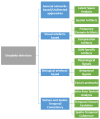Deepfake Media Forensics: Status and Future Challenges
- PMID: 40137185
- PMCID: PMC11943306
- DOI: 10.3390/jimaging11030073
Deepfake Media Forensics: Status and Future Challenges
Abstract
The rise of AI-generated synthetic media, or deepfakes, has introduced unprecedented opportunities and challenges across various fields, including entertainment, cybersecurity, and digital communication. Using advanced frameworks such as Generative Adversarial Networks (GANs) and Diffusion Models (DMs), deepfakes are capable of producing highly realistic yet fabricated content, while these advancements enable creative and innovative applications, they also pose severe ethical, social, and security risks due to their potential misuse. The proliferation of deepfakes has triggered phenomena like "Impostor Bias", a growing skepticism toward the authenticity of multimedia content, further complicating trust in digital interactions. This paper is mainly based on the description of a research project called FF4ALL (FF4ALL-Detection of Deep Fake Media and Life-Long Media Authentication) for the detection and authentication of deepfakes, focusing on areas such as forensic attribution, passive and active authentication, and detection in real-world scenarios. By exploring both the strengths and limitations of current methodologies, we highlight critical research gaps and propose directions for future advancements to ensure media integrity and trustworthiness in an era increasingly dominated by synthetic media.
Keywords: audio deepfake detection; deepfake attribution and recognition; deepfake authentication techniques; deepfake detection; media forensics.
Conflict of interest statement
The authors declare no conflicts of interest.
Figures






References
-
- Goodfellow I., Pouget-Abadie J., Mirza M., Xu B., Warde-Farley D., Ozair S., Courville A., Bengio Y. Generative Adversarial Nets. Adv. Neural Inf. Process. Syst. 2014;27
-
- Ho J., Jain A., Abbeel P. Denoising Diffusion Probabilistic Models. Adv. Neural Inf. Process. Syst. 2020;33:6840–6851.
-
- Casu M., Guarnera L., Caponnetto P., Battiato S. GenAI Mirage: The Impostor Bias and the Deepfake Detection Challenge in the Era of Artificial Illusions. Forensic Sci. Int. Digit. Investig. 2024;50:301795. doi: 10.1016/j.fsidi.2024.301795. - DOI
-
- Wang S.Y., Wang O., Zhang R., Owens A., Efros A.A. CNN-Generated Images are Surprisingly Easy to Spot …for Now; Proceedings of the IEEE/CVF Conference on Computer Vision and Pattern Recognition; Seattle, WA, USA. 13–19 June 2020; pp. 8695–8704.
LinkOut - more resources
Full Text Sources

